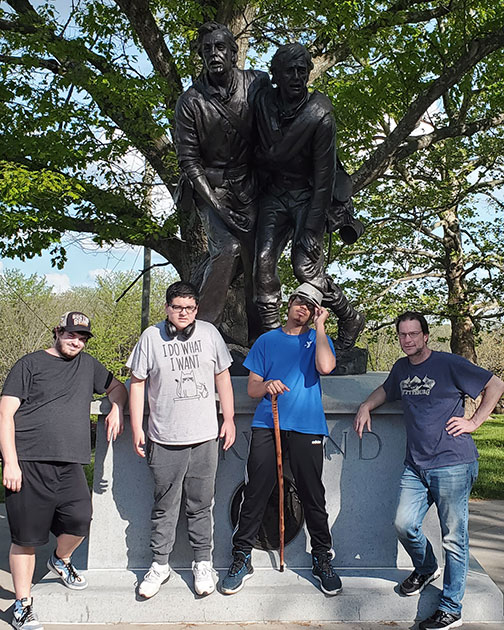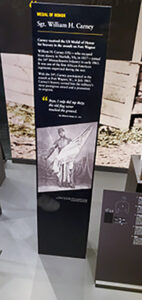Rooted in History
John Charow, vocational director/lead teacher at Seaport Academy, helps his students learn about history by immersing them in the locales where historic events have taken place or are commemorated. “I think it’s very important to do that when we can,” John explains. “Clearly, we’re in Boston with Revolutionary War reminders everywhere – the British, the Redcoats, Lexington, Concord.” Growing up, John went on family vacations to historic places like Williamsburg and Gettysburg. “That sparked an interest in me,” he explains. “so I like to try and bring that to my students.”
John led the annual Seaport trip to Washington, D.C., this spring, where the students visited the Holocaust and African-American Museums. They had the opportunity to see artifacts that brought to life what they had been studying in the classroom. They also visited Gettysburg. “That one’s special to me,” John explains. He sees Gettysburg as the place where the United States started a trajectory towards a more just society, one that gets us closer to the ideals embodied – not necessarily always realized – in the U.S. Constitution.
 Building an Opening
Building an Opening
Experiences like the trip to Gettysburg provide an opening for conversations about working past cultural and personal differences to build relationships. John explains, “I talk to the guys about how everyone’s going to have different opinions. The only person that’s an expert on their opinion is them. But we need to teach our students to realize that other people’s opinions matter and where people are coming from matters.”
According to John, that’s much easier when people have built trust and understanding through relationships. Using examples of conflicts in history, he helps students realize that keeping the lines of communication open strengthens relationships that, in turn, lessen conflict. “Students build relationships that lead to a discussion,” he shares, “and we move forward from there.”
Learning history through place also helps students better understand their place in their community and the world and helps them reclaim pride in themselves. For example, John tells the story of Billy.*
Building Pride
“I was at an open house talking to a parent about the upcoming Gettysburg trip and learned that Billy’s great, great, great uncle was in the 54th Mass. [Infantry Regiment],” John recounts. “He was the first African American to receive the American Congressional Medal of Honor. I said, ‘No way,’ and she tells me the whole story.”
In the movie Glory, the Denzel [Washington] character was based loosely on Billy’s ancestor William H. Carney who was honored for heroism. He picked up the flag, saving the regimental colors, during the Battle of Fort Wagner in 1863 when the soldier who first carried it was shot. John explains, “This is like having our students touch a layer of history.”
Fast forward to a trip to Washington, D.C. As students exited the Metro, they encountered the National African-American Civil War Memorial. John shares, “The memorial is a magnificent bronze around which are benches. There are 200,000 plus African Americans who fought in the Civil War – both North and South. And it’s arranged by state and by unit.
“‘I said, Billy, Billy, come here.’ And I tell him about the units and say, ‘Let’s go look for your great, great, great uncle.’”
Together, John and Billy find the name. Drawn into the moment with Billy, John describes the young man’s excitement, saying he almost felt like Carney was his ancestor. Then other students come over, and Billy tells them about his ancestor. “Suddenly six high school boys are in this moment,” John recalls, “just sharing this connection.
 “Those are the things about teaching history. If you can find those connections, and all of us have them, and every spot where you’re sitting right now, where I'm sitting right now has a history.”
“Those are the things about teaching history. If you can find those connections, and all of us have them, and every spot where you’re sitting right now, where I'm sitting right now has a history.”
And that history was amplified further when on another Civil War Palooza trip, many years after Billy completed his time at Seaport, the new group of students visited the Tredegar Iron Works museum in Richmond, Va., and found a picture of William Carney holding the flag. They also learned that the West Point Cemetery in Norfolk, Va., has a 10-15-ft high granite obelisk of William Carney. John bought the book and sent it to Billy and vowed that he is taking Billy there someday, “if I have to save box tops to get him there.”
“You don't hear of William Carney,” says John. “These are the stories that we have to find, and those are the stories that we have to tell, the average people whose stories are overlooked.”
Building Connection
That’s why John believes, “The places are important. And you can make the connection.” For example, John takes the students to Charlestown, Mass., and shows them where the British stormed Boston. He asks them to think about the young men their age who never made it back to Britain. And when all they see is concrete and asphalt, John has the opportunity to explain the area's history and how Boston was enlarged through land expansion.
Actually, visiting a place lets students put themselves in the shoes of the people who rarely or never make it into the history books. “It legitimizes what they are learning,” says John. “It gives them a context you cannot get with letters on a page, and some of our kids have a hard time with the letters on the page.”
Physically being in a place also expands students’ understanding of who came before them. And, as in the case of Billy, amplifies the pride they have in who they are. States John, “It’s like the MasterCard commercial. It’s priceless.”
* The student’s real name is not used.
